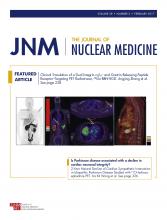Abstract
Only a minority of esophageal cancers demonstrates a pathologic tumor response (pTR) to neoadjuvant chemotherapy (NAC). 18F-FDG PET/CT is often used for restaging after NAC and to assess response. Increasingly, it is used during therapy to identify unresponsive tumors and predict pTR, using avidity of the primary tumor alone. However, definitions of such metabolic tumor response (mTR) vary. We aimed to comprehensively reevaluate metabolic response assessment using accepted parameters, as well as novel concepts of metabolic nodal stage (mN) and metabolic nodal response (mNR). Methods: This was a single-center retrospective U.K. cohort study. All patients with esophageal cancer staged before NAC with PET/CT and after with CT or PET/CT and undergoing resection from 2006 to 2014 were identified. pTR was defined as Mandard tumor regression grade 1–3; imaging parameters included metrics of tumor avidity (SUVmax/mean/peak), composites of avidity and volume (including metabolic tumor volume), nodal SUVmax, and our new concepts of mN stage and mNR. Results: Eighty-two (27.2%) of 301 patients demonstrated pTR. No pre-NAC PET parameters predicted pTR. In 220 patients restaged by PET/CT, the optimal tumor ΔSUVmax threshold was a 77.8% reduction. This was as sensitive as the current PERCIST 30% reduction, but more specific with a higher negative predictive value (P < 0.001). ΔSUVmax and Δlength independently predicted pTR, and composite avidity/spatial metrics outperformed avidity alone. Although both mTR and mNR were associated with pTR, in 82 patients with 18F-FDG–avid nodes before NAC we observed mNR in 10 (12.2%) not demonstrating mTR. Conclusion: Current definitions of metabolic response are suboptimal and too simplistic. Composite avidity/volume measures improve prediction. mNR may further improve response assessment, by specifically assessing metastatic tumor subpopulations, likely responsible for disease relapse, and should be urgently assessed when considering aborting therapy on the basis of mTR alone.
Footnotes
Published online Sep. 15, 2016.
- © 2017 by the Society of Nuclear Medicine and Molecular Imaging.







